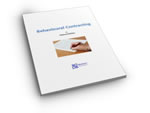 In CBC, emphasis is put on identification of self-defeating thinking and thoughts are elicited by using tools such as a ‘thoughts record form’ where the individual is taught how to identify his or her thinking style.
In CBC, emphasis is put on identification of self-defeating thinking and thoughts are elicited by using tools such as a ‘thoughts record form’ where the individual is taught how to identify his or her thinking style.
The individual is also asked to begin to identify the types of cognitive distortions they engage in which colour their perception of situations. These could include the following:
• Discounting the positive “If I can do it, it doesn’t count”
• All or nothing thinking “I pass or I fail”, “You win or you lose”,”It’s right or it’s wrong”, “I do it all now or do none at all”
• Labelling “I did something bad therefore I am bad”,“I said something silly therefore I am foolish”
• Mind reading “She didn’t look at me therefore I have done something wrong”
• Fortune telling “I just know it will be awful”
• Catastrophising “Oh my God this is SO terrible”
• Personalisation “It’s all my fault”, “I am the one to blame”
• Blame “It’s all his/her/my fault”
• Generalisation “I never get what I want”, “It’s always the same”
• Shoulds, Musts, Have tos and Oughts “I/you/she/he/they must… have to… ought to.”
Once the individual becomes aware of their ways of distorting reality they can put in counter- measures. Instead of seeing a mistake as something awful (catastrophising) and perceiving the situation as being all their fault (personalisation), they could stand back from the situation and think: “I am not happy about the error but it is not the end of the world and I was only responsible for part of what happened. What went wrong and what can I learn that will assist me the next time?”T
This way, it is likely that the individual will be in a better place to correct the error, learn from it and devise systems and/or structures for the future.






